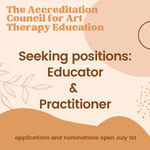 |
||||||||||||||||||||||||||||||
| Archive | Subscribe | Advertise | arttherapy.org | ||||||||||||||||||||||||||||||
We are excited to invite you to submit a proposal to present at the American Art Therapy Association’s 53rd Annual Conference to be held in Minneapolis, MN, November 9 – 13, 2022! Proposals must be submitted online by April 3, 2022.
Traci Bitondo, LPAT, LPC, ATR-BC, ACS, ATCS, New Jersey Art Therapy Association Government Affairs Chairperson It feels so good to finally report this with confidence: New Jersey is licensing art therapists! While that alone is worth celebrating, for New Jersey art therapists, this is particularly amazing given the unexpected, winding journey that took many years.
Ron Hunt, DDS, MS, Chair, Accreditation Council for Art Therapy Education (ACATE) CAAHEP has awarded initial accreditation to the Art Therapy master’s programs at Caldwell University in Caldwell, NJ; Loyola Marymount University in Los Angeles, CA; and the University of Louisville in Louisville, KY, effective January 20, 2022.
Ron Hunt, DDS, MS, Chair, Accreditation Council for Art Therapy Education (ACATE) The Accreditation Council for Art Therapy Education (ACATE) is currently seeking applications and nominations for two (2) Educator and one (1) Practitioner positions that will become open on July 1, 2022. Please consider applying or nominating someone whom you believe will work to promote best practices for art therapy educational programs and help ACATE lead the upcoming revision process for the art therapy accreditation standards.
Deanna Barton, MA, ATR-BC and Zachary D. Van Den Berg, MA, ATR-P, LPC-Associate In February, we celebrate Black History Month by honoring the labors and contributions of Black art therapists towards their clients, the profession at large, and the world. Let us use this month of national recognition to center Black histories, voices, experiences, and ways of knowing as a catalyst for continued inspiration and visibility in art therapy year-round. In support of these goals, we have compiled an art therapy specific resource guide, Black History in Art Therapy: A Living Reference & Resource Guide. In it, we share powerful stories documented in blog posts, newsletters, interviews, presentations, videos, and publications. We hope this guide will be a living resource for information on Black history in art therapy, and we plan to update it regularly (so please consider bookmarking it!
"At the time I was getting started in the ’70s, art therapy was in a very different place, as it was just emerging as a profession. I loved working in the field, but there was little opportunity for financial and professional growth. I felt stuck, like I did not have a ladder to climb. I switched to social work and enjoyed advancing in that career, but I still utilized art therapy when the situation called for it. Recent correspondence with staff at AATA, ATCB, and NYATA; interactions with art therapy colleagues; and attending Zoom presentations sparked my return to art therapy. The new ideas presented on medical and social topics have inspired new hands-on art therapy activities. As I begin this new chapter as an art therapist, I feel much more comfortable and confident with myself."
Did you know that AATA’s Institute for Continuing Education in Art Therapy (ICE/AT) currently offers more than 420 courses, which we present virtually, live or on-demand? In case you missed them live, we want to reshare these popular trainings now available on demand:
⇒ Our first-ever training offered in Spanish, Arte, Vejez y Migración: una adaptación de la Terapia Cognitiva Conductual Focalizada en Trauma (TFCBT) para trabajo creativo con inmigrantes de la Tercera Edad, conducted by Nadia Paredes, MA, LMFT, ATR. ⇒ Exploring Art Therapy Assumptions through the Lens of Neuroscience, conducted by Christianne Strang, PhD, ATR-BC.
Huffington Post “If you are looking to start a regular practice for self-care, try to choose something that is sustainable for you, meaning that it is affordable and you have regular access to it."
Journal-News Part of the study “is to see how art therapy can decrease people’s levels of depression and improve their overall quality of life,” Meera Rastogi said. So patients will use art-therapy through an app, and see how the electronic art exercises help. Some patients in the study will use only the art therapy app, while the others will have both the art therapy and the robotic dogs.
Indy Week “Art-making is inherently therapeutic. [Art therapy] creates a space for people to have the benefits of just processing the meaning and content of whatever comes up in their artwork. It’s using art in order to better express yourself or discover certain patterns that you’re engaging in.”
Times Colonist “Every year, Victorians throw away 134,000 tonnes of garbage. A large portion of these materials could be diverted for creative reuse,” said Ashley Howe, executive director of SUPPLY Victoria.
NPR The therapists take no issue with the main aim of the legislation, which is to prevent patients from being blindsided by bills…. Instead, they are concerned about another part of the law — a price transparency provision…. That's unfitting for mental health care, therapists say, because diagnoses can take time and sometimes change over the course of treatment.
Cleveland.com The Beck Center for the Arts is displaying Cleveland artist Julie Schabel’s new exhibit “Printer Wonderland” in its Music/Creative Arts Therapies Building.... Focusing on photo-based printmaking, Schabel makes repetitious patterns based on natural imagery. The canvases transform into optical illusions as she adds layers and colors to the composition.
WTOP One of the problems identified in the study was that most school systems lack the nationally recommended ratios of mental health professionals: One psychologist for every 500 students; One social worker for every 250 students; One counselor for every 250 students. The New York Times "This is not the end. It is a change, albeit the largest and most dramatic transformation that many of us have seen in our lifetimes. Change is often frightening. We strive for stability. Because of the stress change causes, we often shrink or freeze in the face of it. But there is a hack to prevent that panic, and it is called history." |
||||||||||||||||||||||||||||||
|
The AATA's Art Therapy Today includes a digest of the most important news selected for the AATA from thousands of sources. Guest articles may be submitted to info@arttherapy.org. Publication of any guest article is at the sole discretion of the AATA. The opinions expressed and/or contents of guest articles, advertisements, and external links included in any AATA publication do not represent the positions or policies of the AATA. The AATA makes no warrenty or representation concerning the accuracy of such content. |
||||||||||||||||||||||||||||||










